Nonviolent Communication Basics: 4 Eye-Opening Truths
Many people ask me about the difference between Nonviolence Communication basics and the Noll Affect Labeling System. This lengthy article explains those differences.
Fundamentally, we peacemakers want to minimize human conflicts, calm people down, solve problems, and make durable agreements for lasting peace. Peacemaking and mediation help achieve these goals.
Unfortunately, as will be explained, psychologists, counselors, therapists, peacemakers and mediators have mistakenly tried to create empathy through the use of “I” statements during active listening. “I” statements are important, but not for creating empathy and certainly not for de-escalating anger or other strong emotions.
The inappropriate use of “I” statements comes from a misunderstanding of the work of Thomas Gordon, the inventor of active listening, and Marshall Rosenberg, the creator of Nonviolent Communication.
The Predecessor to Nonviolent Communication-The Gordon Method
Thomas Gordon was an American clinical psychologist and colleague of Carl Rogers. He was widely recognized as a pioneer in teaching communication skills and conflict resolution methods to parents, teachers, leaders, women, youth and salespeople. He developed the Gordon System for building and maintaining effective relationships.
Gordon coined the phrase “active listening” to distinguish his method from normal, passive listening.
The Central Premise of the Gordon System
Gordon identified 12 categories of statements that communicate rejection: ordering, warning, moralizing, advising, teaching (logical argument), judging, praising, name-calling, interpreting, reassuring, probing, and diverting. These responses imply a “you,” such as
“You stop that!”(Ordering),
“You had better quiet down or else!”(Warning), or
“You ought to know better!”(Moralizing), etc.
Gordon believed that an “I-message” would be more effective at resolving a potential conflict. People receiving “you” messages would become defensive or resentful and more likely escalate matters.
Gordon thought if one’s feelings were expressed without blame, the other person would be more likely to change behavior. Gordon believed “I-messages” created a more effective confrontation because they avoided negative evaluations of others, and theoretically promoted a willingness to make a positive change.
According to Gordon, an “I-message” must have three components:
First, the message must state what is unacceptable and describe it in a non-blaming, non-judgmental way. Generally, this would start with “when” i.e.: “When I find the papers left on the floor….”
Second, the message must describe the tangible or concrete effect of the situation or behavior on the speaker, i.e.: “When the paints are not returned to the cupboard (non-judgmental description), I have to waste a lot of my time collecting them and putting them away…. (tangible effect).”
Gordon believed that people seldom modified their behavior unless they realized it had a tangible undesirable effect on another.
Third, the message must contain the feeling generated within the speaker, i.e. “When you have your feet in the aisle (description of behavior), I’m apt to trip over them (tangible effect) and I’m afraid I’ll fall and get hurt (feeling).”
The sequence behavior-effect-feeling puts the cause of the feeling on the effect instead of on the behavior, which may result in a less defensive reaction from the person responsible for the behavior.
Example of the Gordon Method
Situation: A team member has reported that she will not complete a report due today until next week. You are the team leader.
“When you fail to deliver your report on time, I feel frustrated and concerned because our production team must have our reports to be efficient.”
As long as the speaker is focused on her feelings, the use of an “I” statement is appropriate and useful.
The Problem With The Gordon System
The “I” statements in the Gordon System only apply to someone seeking to change the behavior of another. It does not apply to empathic statements directed to another. Gordon knew this and explicitly described active listening as reflecting the feelings of another, especially children.
However, people confused his work with “I” statements as the way to make empathic statements. This led the adoption of the following formula for expressing empathy:
“What I hear you saying is that you are angry,” or
“What I think you are feeling is rage.”
These statements are no longer truly “I” focused. They are “you” focused. The upset person, however, only hears the “I” and immediately feels patronized and emotionally invalidated. Usually, this results in emotional escalation, not de-escalation.
This mistaken formula quickly caught on as the way to express empathy to another by psychologists, counselors, and mediators as a best practice. Of course, this was not what Gordon taught, and common experience tells us that it doesn’t work. Most people hate having “I” statements directed to them when they are upset.
Origins Of Nonviolent Communication
Marshall Rosenberg
Marshall Rosenberg, Ph.D. developed Nonviolent Communication as a process for resolving conflict.
In 1961, Rosenberg received a Ph.D. in Clinical Psychology from the University of Wisconsin. There he met his mentor, humanist psychologist Carl Rogers. Rosenberg credits Rogers with alerting him to the skill and value of empathic listening.
Rogers did not have an understanding of how to speak, only how to listen. Rogers theorized that “congruence” was a key component of helping relationships. Unfortunately, he did not teach what comprised congruence or how to create it in the therapeutic relationship.
As described above, Thomas Gordon, a student of Rogers 20 years before Rosenberg, began writing about “I messages,” and “active listening” terms for which he is the creator, in the early 60s. Gordon was the first person to teach how to listen and speak beyond basic functional communication.
Although they allegedly never read each other’s work or were colleagues, Rosenberg’s formulation of Nonviolent Communication is a slight variation on the Gordon System. The two formulations are so similar that I speculate that Rosenberg probably adopted Gordon’s work in creating Nonviolent Communication.
What is Nonviolent Communication
Nonviolent Communication (NVC) claims to teach people compassionate communication skills by focusing on expressing observations, feelings, needs, and requests to others in a way that avoids diagnostic language or language that labels or defines others. This is essentially the same purpose of the Gordon System.
Nonviolent Communication basics claim to facilitate the capacity to express oneself without the use of good/bad, right/wrong judgment. Similar to the Gordon System, NVC emphasizes expressing feelings and needs, instead of criticisms or judgments.
Nonviolent Communication Basics
The Nonviolent Communication steps include two parts: honest expressions to others, and empathically hearing others through four components – observations, feelings, needs, and requests (referred to as OFNR).
Nonviolent Communication training claims to sharpen awareness of language so that people can express what really matters to them and hear what really matters to others.
By its very nature, and like the Gordon System, the Nonviolent Communication technique is “I” centered.
This is what a typical nonviolent communication confrontation looks like:
Situation: A team member has reported that she will not complete a report due today until next week. You are the team leader.
Here is the Nonviolent Communication formulation:
“I hear you say you won’t have the report complete until next week and I’m feeling some frustration and concern. It is important to me that our team is timely on reports to the production team can be efficient. Would you tell me what’s preventing you from completing the report, and what our team might do to get it finished by 4 pm tomorrow?”
For comparison, here is the Gordon formulation:
“When you fail to deliver your report on time, I feel frustrated and concerned because our production team must have our reports to be efficient.”
The only difference between these formulations is the Nonviolent Communication basic formula contains a request while the Gordon System formulation does not.
Nonviolent Communication Is Based On a Flawed Central Premise
Nonviolent Communication practitioners describe conflict as originating from unmet human needs. Other human conflict theorists such as John Burton and his Human Needs Theory have also hypothesized that conflict arises from unmet needs. Abraham Maslow’s hierarchy of needs has influenced much of this thinking. While the idea of conflict originating from unmet needs seems true, no science supports the hypothesis.
In fact, two central questions bog down human needs theorists:
First, what is a human need? Science shows us that the perception of need is contextual, not fixed. Where you are in your life, your socio-economic status, even your culture all influence how you would describe your needs. Thus, universal needs cannot easily be described.
Second, how do we know when a need has been met? In other words, because needs are personal and subjective, there is no objective way to measure the satisfaction of a need.
Nevertheless, Nonviolent Communication assumes that someone else will fulfill my unmet need if I express it nonjudgmentally. Conflict arises in the way that we ask or demand that our needs be met. NVC practitioners seek to avoid the use of fear, guilt, shame, blame, coercion, or threats when seeking needs satisfaction.
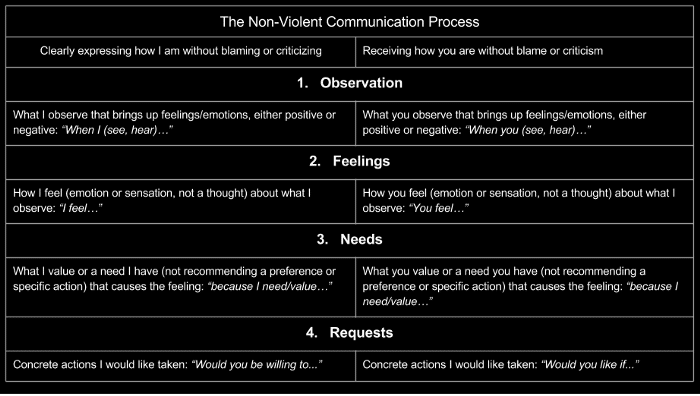
Nonviolent Communication’s central premise is that humans must rely on other humans to have basic needs met, especially relationship needs. Implicit in this premise is that humans are unable to meet their own needs and are therefore dependent on others.
Of course, this defines co-dependency, a dysfunctional form of relationship.
The premise also implicitly assumes human adults are no better than infants. Babies rely on caregivers to have their physical needs met. Over time, healthy children learn to meet their emotional needs from within as they become emotionally competent. Many adults never grow out of the idea that other people will meet their needs. They become angry and resentful when their unspoken, unmet needs are not satisfied.
Thus, a self-aware, emotionally mature adult will not look to another person for love, appreciation, or acceptance. Instead, that person will love herself, appreciate herself, and accept herself. When she experiences a loss of love, appreciation, or acceptance, she must look within, not to external validation or satisfaction.
Nonviolent Communication implicitly rejects this idea. It claims that by stating one’s needs openly and honestly, one is more likely to have another person fulfill those needs without conflict. It ignores the ability of one to meet her own needs internally.
Other Problems with Nonviolent Communication
In addition to resting on a flawed premise, researchers have found other challenges with Nonviolent Communication.
First, learning and mastering the Nonviolent Communication basics takes many months of practice. It is not easy to learn because it is an unnatural way of thinking and communicating. Skilled practitioners must be self-aware, schooled in advanced verbal skills, and able to make the verbal mechanics of the formula sound natural. Most people are not motivated to master these skills.
Second, using the Nonviolent Communication technique takes time, discipline, and patience. Most conflict situations arise quickly and do not allow for the extended discourse required by Nonviolent Communication basics.
Third, because Nonviolent Communication is a skill used from the speaker’s frame of reference, it cannot de-escalate anger or strong emotions. At best, it can help someone who perceives an offense to call out the problem without anger.
Nonviolent Communication will not de-escalate anger or incipient violence because it is “I” centered, not “you” centered. The speaker’s emotional experience is unimportant to the nonviolent communication practitioner.
Fourth, as with the Gordon System, many people feel manipulated and patronized when a Nonviolent Communication practitioner attempts to have a “compassionate communication.”
Fifth, Nonviolent Communication leads to crude paraphrasing, which leaves people feeling discomforted by directive or suggestive reflections.
The Noll Affect Labeling System
The Noll Affect Labeling System arose as a method of de-escalating strong emotions in mediations. As a lawyer-turned peacemaker, I experimented with many different listening techniques, including the Gordon System and Nonviolent Communication. I found them ineffective for defusing intense situations.
The Central Premise of the Noll Affect Labeling System-Emotional Validation
The central premise of the Noll Affect Labeling System is that humans are emotional, not rational. This premise flows from findings in modern neuroscience that show emotions as dominating rationality during consciousness.
The premise is contrary to the central premise of western culture: that what separates humans from other animals is rationality. Humans have limited rationality, sometimes called bounded rationality, but are not all-logical.
Instead, humans live an emotional existence. The problem is that western culture denies emotions, claiming they are bad, irrational, weak, and out-of-control. The denial of emotions, that which makes us human, is the cause of most human conflict.
When we can identify and acknowledge our own emotions and do the same for others, we can de-escalate conflict to allow ourselves to be rational. Until strong emotions are calmed, no amount of rationality or problem solving will be effective.
How To Listen Others Into Existence
The Noll Affect Labeling System has 3 steps:
- Ignore the words
- Listen to the emotions
- Reflect back the emotions with a simple “you” statement
When a listener successfully executes these three steps, the speaker will immediately calm down.
I call this “Listening others into existence.”
Here’s a YouTube Video of how to use these de-escalation techniques to calm an angry child. The same principles apply to adults.
The Science of the Noll Affect Labeling System
Human brains operate pretty much the same way in escalated, angry circumstances. An angry brain, no matter the culture, ethnicity, age, or sex, works the same way. Anger is an intensely emotional experience.
As you know from experience, anger intensifies emotional reactivity. People become extremely angry without much provocation. They may become violent.
Every angry person has lost frontal cortex control. They are unable to self-regulate and are generally unaware. They are in a purely reactive frame of mind.
Angry people also become temporarily alexithymic. Alexithymia is the inability to name your emotions. Most people have weak sell-labeling skills to begin with. When anger arises, the ability to name one’s emotions is lost, which means the prefrontal cortex that controls behaviors and makes choices is shutdown.
The upshot is that angry people suffer from a temporary loss of emotional self-regulation. Most people cannot get themselves quickly under control because they are emotionally incompetent. They have low levels of emotional intelligence. Upbringing and culture contribute to emotional incompetency.
The Goal of Effective De-Escalation Is to Re-Boot the Prefrontal Cortex
The Amygdala Hijack
Understanding how to calm an angry person begins with the concept of the amygdala hijack.
The amygdala is a collection of cells near the base of the brain. There are two, one on each side of the brain. The amygdala is a part of the brain’s limbic system. It’s key to how we process strong emotions like fear and pleasure.
When a person feels threatened, the amygdala automatically activates the fight-or-flight response by sending out signals to release stress hormones that prepare your body to fight or run away.
Emotions like fear, anxiety, aggression, and anger trigger this response.
When danger is present, the amygdala wants to automatically activate the fight-or-flight response immediately. However, at the same time, the frontal lobes are processing the information to determine if danger really is present and if there is a logical answer to it.
When the threat is mild or moderate, the frontal lobes override the amygdala, and people respond in a rational, appropriate way. However, when the danger is severe, the amygdala acts quickly. It may overpower the frontal lobes, automatically triggering the fight-or-flight response.
Daniel Goleman called this overreaction “amygdala hijack” in his 1995 book, “Emotional Intelligence: Why It Can Matter More Than IQ.”
The hijack occurs when the amygdala disables the frontal lobes and activates the fight-or-flight response. Without the frontal lobes, people cannot think clearly, make rational decisions, or control behaviors.
This is why people escalate when they are angry. They no longer have rational control over themselves. The only effective de-escalation technique is to help an angry, potentially violent person re-boot the prefrontal cortex so they regain control of themselves.
The Re-Boot Process
The re-boot process must inhibit the over-active emotional circuits of the brain. These circuits include the amygdala, the anterior cingulate cortex, the medial prefrontal cortex, and the polyvagal system in the central nervous system. At the same time, the prefrontal cortex must reactivate.
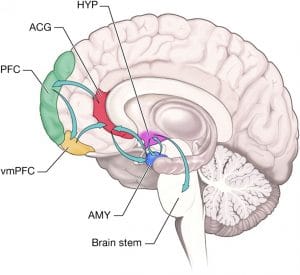
In 2007, UCLA neuroscientist Matthew Lieberman found that when emotions were labeled, the emotional centers of the brain were inhibited while the prefrontal cortex was activated.
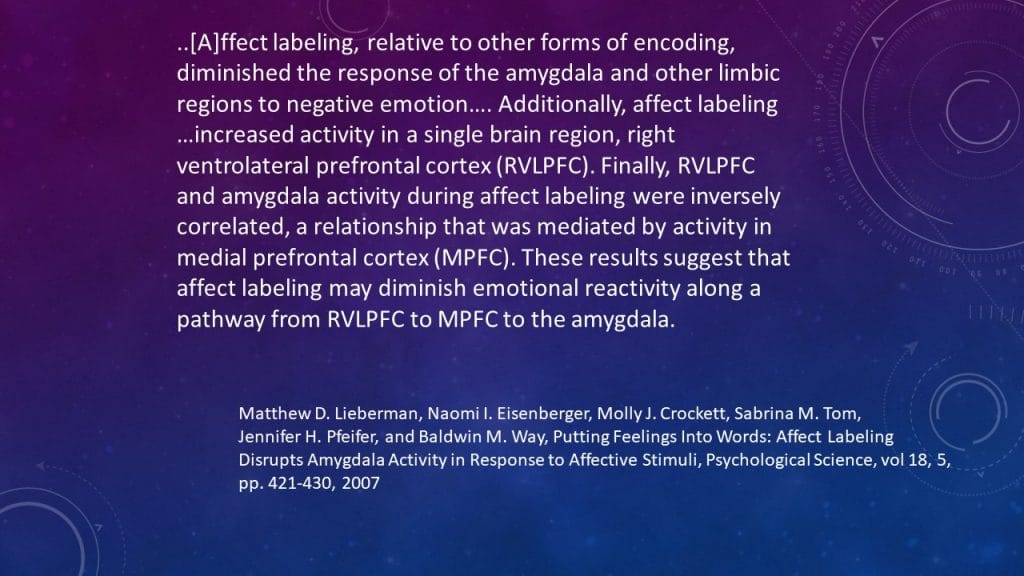
To read Lieberman’s study, click here.
The Noll Affect Labeling System Allows You To Calm An Angry Person In Seconds
In summary, the only useful de-escalation skill is to reflect back emotions with a simple “you” statement. When you use this strategy, you are able:
- To remain calm and non-reactive
- To maintain a non-anxious presence
- To loan your prefrontal cortex to the escalated person
- To calm anyone in any situation in less than 90 seconds
Most people do not have the skills, self-awareness, or knowledge to self-regulate themselves from rage to calm.
Comparing Gordon, Rosenberg and Noll
|
Steps: |
1 |
2 |
3 |
4 |
5 |
| Gordon | State facts or behavior without evaluation using an “I” statement | Express tangible or concrete effects arising from 1, using an “I” statement | Express own feelings with an “I” statement | Ask questions | |
| Rosenberg | Distinguish observations from evaluations | Express own feelings, using an “I” statement and avoid words that imply other’s behavior i.e., “I feel threatened.” | Take responsibility of own feelings by linking them to own needs, values, or expectations. | Express requests instead of demands | Ask questions |
| Noll | Ignore the words | Read the emotional data fields (alternatively, guess at the other’s emotions) | Reflect back the emotions of the other with a simple “You” statement. | Repeat steps 1-3 until the other person is calm, then determine if further processing, e.g. problem-solving, is necessary. | Do not ask questions |
Gordon and Rosenberg focus on “My” feelings and needs. Noll focuses on “Your” feelings and emotions. Rosenberg and Noll offer an opportunity for self-empathy. Noll calls this self-affect labeling. In contrast, Gordon’s Parent Effectiveness Training is intended for application towards others, not self.
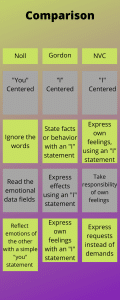
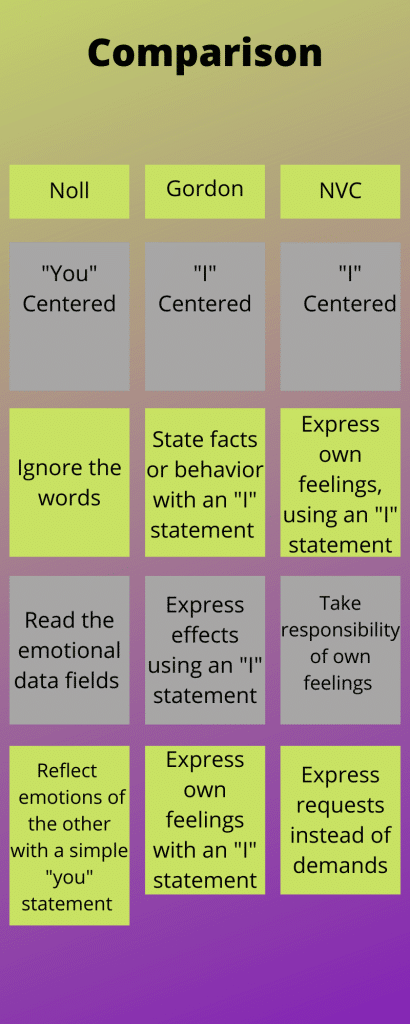
A Comparison of Nonviolent Communication and Noll Affect Labeling
The following example shows the differences between Nonviolent Communication and the Noll Affect Labeling System.
Your teenager has returned your car with an empty tank of gas.
The NVC practitioner might say, “I feel irritated when I see you’ve returned my car with an empty gas tank. Would you fill it up by tonight? I want to trust that I can get to work tomorrow.”
Using affect labeling, the internal and external conversations might go like this:
Internally, to self, “I’m annoyed and frustrated that John brought back the car with an empty tank. I feel disrespected, unappreciated, and pissed off.” (All said silently to one’s self).
Externally, to John: “Hey, I just checked to car to make sure I had enough gas to get to work tomorrow and saw that it is on empty. Tell me what’s going on?” (No blame or judgment in the tone—only honest inquiry.)
“Jeez, Dad, I ran out of time. You guys wanted me back here by 3 pm, and I didn’t want to be late. So I figured I would have to deal with filling the car with gas later.”
“You are anxious and upset and you’re a little embarrassed.”
“Yeah. Exactly.”
“Anything else?”
“I just over-committed myself and ran out of time.”
“You are frustrated with yourself and a little angry with yourself. You let yourself down.”
“Exactly right.”
“Anything else?”
“Nope, That’s about it.”
“OK, how can we make it right?”
“I’ll get gas right after dinner and bring the car right back. Will that be ok?”
“Yes. That will work. Thanks for taking care of it.”
“You are welcome. And thanks for listening.”
4 Eye-Opening Truths About Reflective Listening
“I” Statements Should Only Be Used To State Your Own Feelings
Gordon and Rosenberg were right to teach “I” statements when you talk about your own feelings. You should say:
“I’m anxious and angry.” I’m frustrated.” “I’m sad and alone.”
When you label your own feelings, you are self-affect labeling. This is a powerful process for calming yourself down in any emotional situation.
In addition, if you state your feelings aloud, no one has a right to question, judge, or invalidate you. Your emotions are what they are, and you own them.
Stating your emotions only becomes a problem when you blame someone else for making you feel the way you do.
Do not say, “I am anxious and angry because of you.” “You make me anxious and angry.”
Instead, focus on the behavior, not the person.
“When you talk in a loud voice at me, I am anxious and angry.”
“I” Statements Should Never Be Used To Establish Empathy
Never, ever use “I” statements in expressions of empathy. This error has existed for over 60 years.
Do not say, “What I see you feeling is anxiety and anger.” “It sounds to me like you are angry.” What I hear you saying is ….”
This is emotionally invalidating, rude, patronizing, and manipulative. You don’t like it when others do this to you, so don’t inflict this type of “I” statement on others.
“You” Statements Should Be Used to Reflect Back Another Person’s Emotions
Gordon was wrong to declare that “you” statements should never be used because his statement is too broad. Brain science shows us the power of third-party affect labeling. Therefore, only use a “you” statement when you are reflecting back another person’s emotions.
You would say, “You are anxious and angry.” “You are frustrated.”
Do not add any reason for why the person might be having an emotional experience because you really don’t know. Keep the “you” statements short, direct, and simple.
“You” Statements Should Never Be Used To Judge, Label, Or Condemn Behavior
Gordon correctly states that “you” statements should never be used to judge, label, or condemn.
Don’t say, especially to a child, “You stop doing that.” “You are stupid for saying what you are saying.” “You are such a drama queen.”
These phrases are deeply invalidating and emotionally abusive.
Deep reflective listening is the most powerful relationship tool in your toolbox. Remember these four simple truths and you will see immediate and profound transformations around you.
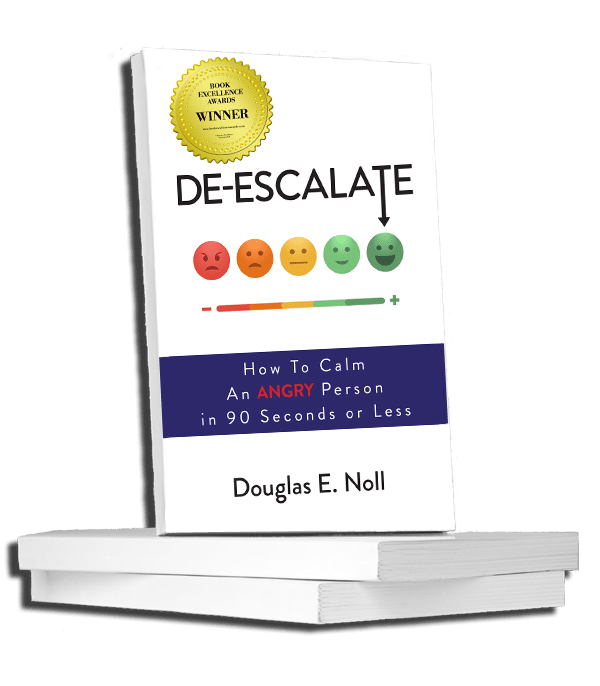
Hi Arianne, Thanks for your comment. One point of clarification. That is, identifying another’s emotions is not hard. Our brains are hard-wired to do this. My clients typically master this skill in 6 weekly one-hour sessions. The biggest problem is overcoming the cultural and social impediments to reading and reflecting emotions. In addition, a new study came out last week showing that the therapist-patient bond is weakened when the therapist uses self-referential statements (“I”, “me”), further supporting my point that only “you” statements should be used in reflective listening. Take a look at “A natural language processing approach reveals first-person pronoun usage and non-fluencyas markers of therapeutic alliance in psychotherapy“, Jihan Ryu, Stephen Heisig, Caroline McLaughlin, Michael Katz, Helen S. Mayberg, and Xiaosi Gu.
Thank you for that article. It’s interesting to look at the distinctions you make between the 3 methods. Your description of NVC doesn’t seem totally complete (at least, not in the way it is tought nowadays), but I agree that it is not perfect and not usable or effective all the time. It’s also quite difficult to really master all the subtilities of it. I would say that when people use it as beginners and take a posture of “knowledge” that is the moment where others experience it as patronizing. But if you can really use it in a more natural way in a conversation, it can be really useful to work on a starting conflict.
I am a psychologist and I use many ways of reflecting and reformulating my client’s words or feelings. I find all three methods useful depending on the situation and on what is going on. The Noll method is great when there is a high emotional activation and that the client isn’t able to self-label his feelings. However, reading beyond words and identifying another person’s emotion can be tricky and needs training. If the statement doesn’t work with what the person is feeling, that can trigger even more emotion.
I usually use a mix of Gordon and Noll in this case, verifying with my client my interpretation. That is usually a good mix of respect and empathy.
I am a certified trainer in Nonviolent Communication, NVC, as developed by Marshall Rosenberg. For me, NVC is a miracle. I have used NVC in the last 12 years to reconcile people that have tried to kill each other and to support people avoiding violent confrontation as well as resolving conflicts peacefully.
With all my education in NVC and all my experience in NVC, I can say that this article does not reflect neither what NVC is nor what people can accomplish with NVC.
Besides this, I find the article interesting and food for thought.
Best regards, https://www.cnvc.org/trainers/carl-plesner
[…] You (using an “I” statement), “I understand how you feel. We will get this figured out.”Nonviolent Communication Basics: 4 Eye-Opening Truths […]
Hi Alison,
I have not read Ms. Payton’s book. However, looking at some of the book reviews. I suspect that she is not using affect labeling. She is an NVC teacher, so I would expect her to stick with the Rosenburg formula using “I” statements instead of “you” statements. However, since I have not read the book, I cannot say for certain if she is using affect labeling. Thanks for visiting here. I hope you will sign up on my list to get my weekly new articles.
Best,
Doug
Hello Doug,
This article is very interesting. I have studied NVC and find much of what you have written to resonate with me.
I have been reading Your Resonant Self by Sarah Payton. I guess it is Self Affect Labeling. I was wondering if you are familiar with her work. Thank you for your writing
[…] active listening […]
[…] nonviolent communication basics […]
[…] nonviolent communication basics […]
[…] active listening […]
[…] active listening […]
[…] You statements or I statements? […]
[…] You statements or I statements? […]
[…] nonviolent communication basics […]
[…] nonviolent communication basics […]
[…] Active Listening Tips. Nonviolent Communication Basics: 4 Eye-Opening Truths Many people ask me about the difference between Nonviolence Communication basics and the Noll Affect Labeling System. This lengthy article explains those differences. Fundamentally, we peacemakers want to minimize human conflicts, calm people down, solve problems, and make durable agreements for lasting peace. Peacemaking and mediation help achieve these goals. Unfortunately, as will be explained, psychologists, counselors, therapists, peacemakers and mediators have mistakenly tried to create empathy through the use of “I” statements during active listening. […]
[…] nonviolent communication basics […]
[…] not make the mistake of using an “I” statement. This type of active listening is based on old 20th century ideas that have been proven by neuroscience to be bogus. When you use and “I” statement to […]
[…] nonviolent communication basics […]
[…] nonviolent communication basics […]
[…] active listening […]